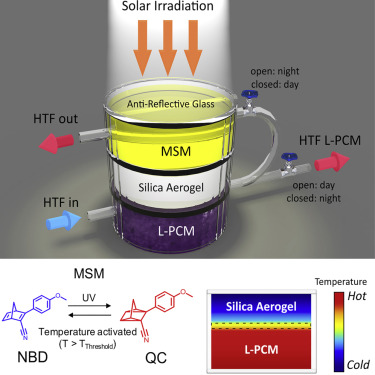(Clear, conductive coating could protect advanced solar cells, touch screens)
2019/11/22 アメリカ合衆国・マサチューセッツ工科大学(MIT)

・ MIT が、シングルステッププロセスで作製する透明導電膜を開発。
・ タッチスクリーンや太陽電池用の透明導電膜は、酸化インジウムスズ(ITO)が広く利用されているが、脆い性質のため長期間の使用で割れることがある。
・ 同大学が 2 年前に開発した透明導電膜では、導電率が 50S/cm で ITO のそれ(6,000~ 10,000S/cm)には及ばなかったが、今回、3,000S/cm を達成。
・ 同材料は、高性能でフレキシブルな有機ポリマーである、PEDOT のナノスケール薄膜。酸化化学蒸着(oCVD)プロセスにより、ポリマーを構成する微細な結晶構造が水平に整列することで高い導電性を達成。さらに、同プロセスによる結晶子内のポリマー鎖の積層距離短縮も導電性の向上に貢献。
・ このような PEDOT 層をペロブスカイト太陽電池と組み合わせ、その有用性を実証。ペロブスカイト太陽電池は、その高効率性と製造の簡便性によりシリコンの代替が期待されているが、耐久性が課題。oCVD 法による PEDOT 層を取り入れることで、その効率性が向上し、安定性が倍増した。
・ 初期試験では直径 6 インチの基板に PEDOT 層を成膜したが、ITO 製造時よりも大幅に低い 140℃ での処理が可能なため、同プロセスは産業用の大規模なロール・ツー・ロール製造法に直接適用できる。・ 同 oCVD プロセスによる PEDOT 層は、適度なシングルステッププロセスでプラスチック基板に直接成膜できるため、フレキシブルな太陽電池やディスプレーに理想的。一方、極度な成長条件下で成膜する他の透明導電材料の多くでは、より強靭な基板への蒸着後、剥離してプラスチックに転写させる複雑なプロセスを要する。
・ 乾式の蒸着プロセスの同 oCVD 法では、超微細な表面形状でも均一に成膜可能なため、特定のアプリケーションに有用。例えば、布地に処理して繊維毎にコーティングしても布地の通気性を維持する。
・ 大規模実証による多様な条件下での長期安定性の実証に向け、同研究を継続する。今後の課題は商業化に向けた投資の有無。
・ 本研究は、Eni-MIT Alliance Solar Frontiers Program の下、Eni. S.p.A(イタリアの半国有石油会社)が支援した。
URL: http://news.mit.edu/2019/coating-solar-cells-touch-screens-1122
(関連情報)
Science Advances 掲載論文(フルテキスト)
Tuning, optimization, and perovskite solar cell device integration of ultrathin poly(3,4-ethylene dioxythiophene) films via a single-step all-dry process
URL: https://advances.sciencemag.org/content/5/11/eaay0414
<NEDO海外技術情報より>
Abstract
For semicrystalline poly(3,4-ethylene dioxythiophene) (PEDOT), oxidative chemical vapor deposition (oCVD) enables systematic control over the b-axis lattice parameter (π-π stacking distance). Decreasing the b-axis lattice parameter increases the charge transfer integral, thus enhancing intracrystallite mobility. To reduce the barrier to intercrystallite transport, oCVD conditions were tailored to produce pure face-on crystallite orientation rather than the more common edge-on orientation. The face-on oriented oCVD PEDOT with the lowest b-axis lattice parameter displayed the highest in-plane electrical conductivity (σdc = 2800 S/cm), largest optical bandgap (2.9 eV), and lowest degree of disorder as characterized by the Urbach band edge energy. With the single step oCVD process at growth conditions compatible with direct deposition onto flexible plastic substrates, the ratio σdc/σop reached 50. As compared to spun-cast PEDOT:polystyrene sulfonate, integration of oCVD PEDOT as a hole transport layer (HTL) improved both the power conversion efficiency (PCE) and shelf-life stability of inverted perovskite solar cells (PSC).


